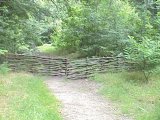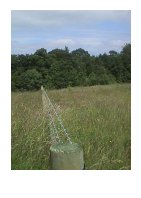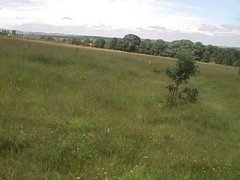

 (yr 2000).
"Caeser's Camp" is the name given to a Late Neolithic double ditch henge which is situated in a small area of Ancient woodland. The wood is called Scholes Coppice and has never been anything but woodland, so should not be maintained or altered in any way. This could upset the balance of it's ecosystem and lead to a breakdown.
The henge has a Roman name, as do several other features in the area, such as a large ridge to the North East which is locally called a Roman ridge, but there is no reason for giving credit for this to the Romans either. The henge is one of our oldest pre-historical monuments. It is buried under trees and general undergrowth and was undisturbed until the building of the housing estates around it, mainly Kimberworth Park which was built in the early 1950's.
For many years the local council have planned a road which would cut through Scholes Coppice but have been unable to develop it. Recently they announced the forthcoming building of 12,00 houses and a shopping centre and school to the North of Scholes Coppice in the land around Thorpe Hesley which borders on that side and is a small village.
(yr 2000).
"Caeser's Camp" is the name given to a Late Neolithic double ditch henge which is situated in a small area of Ancient woodland. The wood is called Scholes Coppice and has never been anything but woodland, so should not be maintained or altered in any way. This could upset the balance of it's ecosystem and lead to a breakdown.
The henge has a Roman name, as do several other features in the area, such as a large ridge to the North East which is locally called a Roman ridge, but there is no reason for giving credit for this to the Romans either. The henge is one of our oldest pre-historical monuments. It is buried under trees and general undergrowth and was undisturbed until the building of the housing estates around it, mainly Kimberworth Park which was built in the early 1950's.
For many years the local council have planned a road which would cut through Scholes Coppice but have been unable to develop it. Recently they announced the forthcoming building of 12,00 houses and a shopping centre and school to the North of Scholes Coppice in the land around Thorpe Hesley which borders on that side and is a small village.
The council also decided that after thousands of years the wood needs their management and they cut down many mature trees, put roads into the wood cutting the henge outer ditch, sent men into the wood to shoot squirrels and presumably sold the wood from the trees they had felled. Also, they put a fence to the top of the wood in the area known as Keppels and put Highland cattle there to graze to enrich the ground for the wild flowers but instead of Orchids there is Heather and Bullrushes


The wild flowers growing outside the fence will have to fend for themselves when the bulldozers arrive.

The henge was dated by the department of Archaeology and Prehistory at the University of Sheffield and is supposedly under the protection of English Heritage. It has been damaged by people from the houses around walking there and riding bikes over the mounds between the ditches, but now has a wattle fence to prevent anyone other than on foot.
It isn't immediately apparent that there's an Ancient earthwork there unless you are already aware of it. This means that the damage done so far is accidental except of course for the legal vandalism already described which has been done to the woodland in general (photos summer 1998).
 Main page
Main page